

Honeywagon. A honey wagon (vacuum truck) in Cambridge Bay.

Shit stick. Shit stick means "a thin stake or stick used instead of toilet paper" and was a historical item of material culture introduced through Chinese Buddhism and Japanese Buddhism.
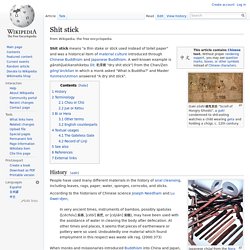
A well-known example is gānshǐjué/kanshiketsu (lit. Bathroom. This article is about private rooms for personal hygiene.

For a public toilet, see public toilet. An average-sized U.S. residential bathroom History[edit] The first records for the use of baths date back as far as 3000 B.C. At this time water had a strong religious value, being seen as a purifying element for both body and soul, and so it was not uncommon for people to be required to cleanse themselves before entering a sacred area.
According to Teresi et al. (2002):[1] The third millennium B.C. was the "Age of Cleanliness. " Nearly all of the hundreds of houses excavated had their own bathing rooms. Anaerobic lagoon. An anaerobic lagoon or manure lagoon is a man-made outdoor earthen basin filled with animal waste that undergoes anaerobic respiration as part of a system designed to manage and treat refuse created by Concentrated Animal Feeding Operations (CAFOs).

Anaerobic lagoons are created from a manure slurry, which is washed out from underneath the animal pens and then piped into the lagoon. Sometimes the slurry is placed in an intermediary holding tank under or next to the barns before it is deposited in a lagoon. Once in the lagoon, the manure settles into two layers: solid, or sludge, layer and the liquid layer. The manure then undergoes the process of anaerobic respiration, whereby the volatile organic compounds are converted into carbon dioxide and methane. Anaerobic lagoons are usually used to pretreat high strength industrial wastewaters, and municipal wastewaters. Anaerobic lagoons have been shown to harbor and emit substances which can cause adverse environmental and health effects.
Sequencing batch reactor. Sequencing batch reactors (SBR) or sequential batch reactors are industrial processing tanks for the treatment of wastewater.

SBR reactors treat wastewater such as sewage or output from anaerobic digesters or mechanical biological treatment facilities in batches. Oxygen is bubbled through the wastewater to reduce biochemical oxygen demand (BOD) and chemical oxygen demand (COD) which makes the effluent suitable for discharge to surface waters or for use on land. Overview[edit] While there are several configurations of SBRs, the basic process is similar. The installation consists of at least two identically equipped tanks with a common inlet, which can be switched between them. Sewerage. Sewerage refers to the infrastructure that conveys sewage.

It encompasses components such as receiving drains, manholes, pumping stations, storm overflows, and screening chambers of the combined sewer or sanitary sewer. Sewerage. Sanitary sewer overflow. Sanitary sewer overflow (SSO) is a condition in which untreated sewage is discharged into the environment prior to reaching sewage treatment facilities.
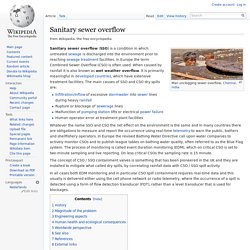
In Europe the term Combined Sewer Overflow (CSO) is often used. When caused by rainfall it is also known as wet weather overflow. It is primarily meaningful in developed countries, which have extensive treatment facilities. Blackwater (waste) Blackwater is a term dating to at least the 1970s[1] used to describe wastewater containing fecal matter and urine.
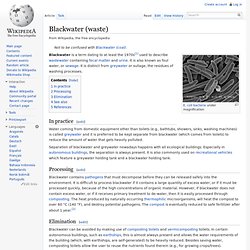
It is also known as foul water, or sewage. It is distinct from greywater or sullage, the residues of washing processes. Water coming from domestic equipment other than toilets (e.g., bathtubs, showers, sinks, washing machines) is called greywater and it is preferred to be kept separate from blackwater (which comes from toilets) to reduce the amount of water that gets heavily polluted. Separation of blackwater and greywater nowadays happens with all ecological buildings. Especially in autonomous buildings, the separation is always present.
Everyone Poops. Everyone Poops is the title of US editions of the English translation (by Amanda Mayer Stinchecum) of Minna Unchi (みんなうんち?)
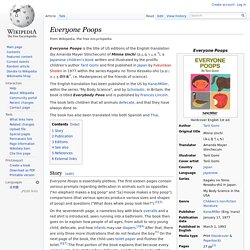
, a Japanese children's book written and illustrated by the prolific children's author Tarō Gomi and first published in Japan by Fukuinkan Shoten in 1977 within the series Kagaku no Tomo Kessaku-shū (かがくのとも傑作集? , i.e. Septage. In the United States, the partially treated waste store in a septic tank is called septage.[1] It generally consists of all the household wastes that are disposed of through a home's plumbing system that neither drain out into the soil nor are converted to gases by the bacteria in the tank.
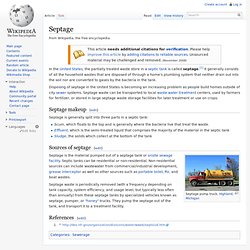
Disposing of septage in the United States is becoming an increasing problem as people build homes outside of city sewer systems. Septage waste can be transported to local waste water treatment centers, used by farmers for fertilizer, or stored in large septage waste storage facilities for later treatment or use on crops. Human gastrointestinal tract. The human gastrointestinal tract, or GI tract, is an organ system responsible for consuming and digesting foodstuffs, absorbing nutrients, and expelling waste.
The tract consists of the stomach and intestines, and is divided into the upper and lower gastrointestinal tracts.[1] However, by the broadest definition, the GI tract includes all structures between the mouth and the anus.[2] On the other hand, the digestive system is a broader term that includes other structures, including the digestive organs and their accessories.[3] The tract may also be divided into foregut, midgut, and hindgut, reflecting the embryological origin of each segment. The whole digestive tract is about nine metres long.[4] The GI tract releases hormones to help regulate the digestive process.
Structure[edit] The structure and function can be described both as gross anatomy and as microscopic anatomy or histology. Upper gastrointestinal tract[edit] Upper and Lower human gastrointestinal tract Small intestine[edit] Waste container. Litter bin redirects here. For a place for pet animals to 'go to the toilet' in, see litter box. A waste container is a container for temporarily storing waste, and is usually made out of metal or plastic. Common terms are dustbin, rubbish bin, litter bin, garbage can, trash can, trash bin, dumpster, waste basket, waste paper basket, waste receptacle, container bin, bin and kitchen bin. The words "rubbish", "basket" and "bin" are more common in British English usage; "trash" and "can" are more common in American English usage.
Curbside dustbins[edit] High-altitude flatus expulsion. High-altitude flatus expulsion (HAFE) is a gastrointestinal syndrome which involves the spontaneous passage of increased quantities of rectal gases at high altitudes.[1] First described by Joseph Hamel in c. 1820[2] and occasionally described afterward,[3] a landmark study of this phenomenon was published in 1981 by Paul Auerbach and York Miller.[1]